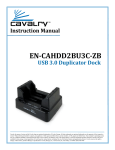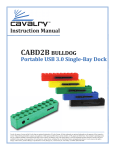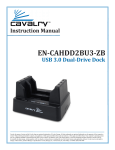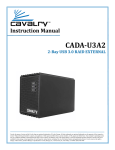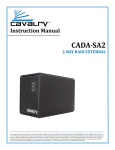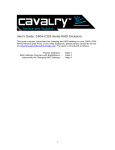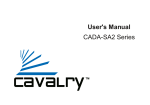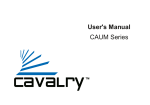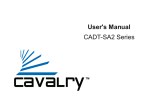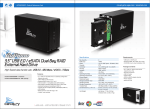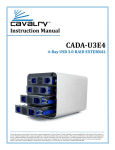Download Cavalry CAHDD2005T01
Transcript
Instruction Manual EN-CAHDD2B-D Dual-Bay USB 2.0 RAID Dock Cavalry, the names of series and the Cavalry logo are registered trademarks of Cavalry Storage. All other trademarks or registered trademarks are the property of their respective owners. When referring to hard drive capacity, one gigabyte, or GB, equals one billion bytes, and one terabyte, or TB, equals one trillion bytes. Your computer’s operating system may use a different standard of measurement and report a lower capacity. In addition, some of the listed capacity is used for formatting and other functions, and thus will not be available for data storage. Actual quantities will vary based on various factors, including: file size, file format, features and application software. Cavalry reserves the right to change, without notice, product offerings or specifications. Cavalry Storage, Inc., 555 East Easy St., Simi Valley, CA 93065, (805) 426-1000 Table of Contents Chapter 1. Getting Started ............................................................................ 1 Features and Application........................................................................................... 1 Specifications ............................................................................................................. 1 System Requirements ................................................................................................ 1 Package Content ........................................................................................................ 1 Product Part Identification ......................................................................................... 2 Description of Dock Settings...................................................................................... 2 Your Disk Management Utility .................................................................................. 3 Chapter 2. installation guide ........................................................................ 3 Installation Outline .................................................................................................... 3 Installation Step 1 ..................................................................................................... 4 Installation Step 2 (JBOD)........................................................................................ 4 Installation Step 2 (RAID 1)...................................................................................... 5 Installation Step 2 (RAID 0)........................................................................................ 6 Installation Step 2 (Spanning)................................................................................... 6 Initialization Step 3 ...................................................................................................... 7 chapter 3. support .................................................................................................. 8 HDD LED Status Codes ........................................................................................... 8 Troubleshooting ..................................................................................................... 8 Warranty Information ................................................................................................. 9 Contact Information ................................................................................................... 9 GETTING STARTED CHAPTER 1 APPLICATIONS FEATURES Thank you for purchasing the Cavalry dual-bay USB 2.0 RAID dock. The EN-CAHDD2B-D was designed for ultimate flexibility. The multiple RAID settings allow users to have several discrete RAID arrays, using multiple disks, and still retain the ability to setup and test new drives on-the-fly. The automatic disk-duplication feature allows you to create sector-to-sector backup images of entire disks. The Plug and Play design means that there are no bothersome drivers to install or update. Just plug in your internal SATA drive(s) and configure them in the disk management utility of your choice! Up to 60MB/S Maximum Transfer Speed With the price of hard disks falling at ever faster rates, it has become common for average computer users to have multiple disks; both used and unused. The EN-CAHDD2B-D RAID dock allows you to put those disks to work. For system builders who can’t afford down-time caused by faulty OS drives, the ultra-simple RAID 1 disk-duplication feature allows you to make complete duplicate disks without connecting to your computer! The hot-swappable dock design allows you to cycle through as many disks as you like, in mere seconds; all without restarting your PC or Mac! SYSTEM REQUIREMENTS OS Compatibility: USB 2.0 for Broad Multi-OS Compatibility Windows 7/Vista/XP/2000, Mac OS X 10.3+ Up to 4 TB Total Capacity (Depending on Your OS) Automatic Disk Duplication via RAID 1 Hardware Requirements: USB 2.0 Port Hard Drive Requirements: 3.5” Desktop, or 2.5” Notebook, Internal Hard RAID 1, RAID 0, JBOD and Spanning modes Drive with SATA II Interface Hot-Swappable Operating Environment: 2.5” and 3.5” SATA II drive support Temperature Operating: 41o - 131o F Non-Operating: 40o - 149o F Relative Humidity Operating: 8% - 90% RH non-condensing SPECIFICATIONS Model #: EN-CAHDD2B-D Interfaces: Internal: 2 x SATA II; External: Non-Operating:5% - 95% RH non-condensing 1 x USB 2.0 - Up to 480Mbit/s Power Supply: 100-240v 50/60 Hz US/ PACKAGE CONTENTS International Auto Switching Configurations: RAID 1, RAID 0, JBOD ,Spanning Dimensions: 6.25” x 4” x 5” Weight: 0.65 lbs. 2-Bay Dock USB 2.0 Cable Power Adapter * Note: Hard drives are not included unless you have purchased a bundle. Bundle contents vary. Speed of dock is limited to the maximum speed of the hard drive in use. EN-CAHDD2B-D 1 GETTING STARTED CHAPTER PRODUCT PART IDENTIFICATION 1 2 3 4 5 6 1 1. Power LED 2. HDD Status LED 3. USB 2.0 Interface Port 4. RAID Configuration Switches 5. DC Power Input 6. Power Switch DESCRIPTION OF RAID-MODES RAID modes and terminology can be a little confusing to the un-initiated. Rather than try to explain the exact mechanisms that underlie each mode, we will describe each one in terms of what they can do. Then, you can carefully choose the appropriate mode for your application. JBOD Mode = Just a Bunch Of Disks. This really isn’t a RAID mode at all. JBOD simply allows you to see each drive separately within either or both bays. There is no performance advantage to JBOD. But, it is very useful when transferring data from one drive to the next; or when you need to error-check individual drives within your disk management utility. Plus, JBOD does not change the file system the way the other modes do. This makes it a safe bet if you are unsure of what mode you should use. RAID 1 Mode = Mirrored Drives. This mode basically duplicates all of the data from one drive onto the next. In other words, it “mirrors” the source drive. This is by far the preferred mode for a RAID array. It provides security for all of your source-drive’s data in the form of a true automatic backup. The catch is that your storage capacity is limited to that of the source drive. You will also need to verify that each disk you intend to use in this array is the exact same make and model. RAID 0 Mode = Striped Drives. This is only recommended for those people who absolutely must have the absolute maximum in transfer speed and storage capacity. This mode is easily capable of exceeding the speed limit of USB 2.0 (roughly 60 MB/s). Likewise, it gives you access to the full capacity of both disks combined. So, what could possibly be bad about that? The problem is this: if one drive dies, all of your data will be lost. In order to safely use RAID 0, you’ll need a third separate drive in which to backup your critical data. You will also need to verify that each disk you intend to use in this array is the exact same make and model. Spanning = BIG Drives. This also is not exactly a RAID array. Spanning joins two drives into one big disk that has the capacity of both disks combined. Unlike RAID 0, there is no speed increase from BIG mode. You can also use different sized disks in a Spanning array. But as with RAID 0, if one drive fails, the entire BIG volume will be lost, along with any potential data. You’ll probably want a third separate drive in which to backup your most critical data. EN-CAHDD2B-D 2 GETTING STARTED CHAPTER YOUR DISK MANAGEMENT UTILITY 1 In Windows, they call it “Disk Management”. In Mac, they call it “Disk Utility”. Despite having different names and appearances, both Windows Disk Management and Mac Disk Utility do basically the same thing: they allow you to create, modify and delete any storage volume connected to your computer. In order to get the most out of your EN-CAHDD2B-D dock, you will need to become intimately familiar with your disk management utility. Please refer to a detailed glossary on our website of the terms and explanations of the functions and procedures you will need to understand [http://www.cavalrystorage.com/manuals.aspx]. It’s generally a good idea to keep your disk management utility continuously open while you are setting up your dock and the disks within it. How to Find Your Disk Management Utility Windows: Navigate to Disk Management: Start Menu>right-click (My) Computer>select “Manage”>select Disk Management. Mac: Click an empty space on your Desktop. Then select (from the top of the screen) Go>Utilities>Disk Utility. “Seeing” Your New Disk in the Disk Management Utility In Mac, this is a pretty straight-forward affair. Just look at the left-hand column, and search for a newly added disk with the term “DMI” or “USB” in it’s title. Windows arbitrarily assigns a “Disk Number” to every new disk that is connected; even if the disk does NOT show up in (My) Computer. “Disk 0” is always your system or C: drive. Your Cavalry drive will appear somewhere beneath Disk 0. It will be given a number, like Disk 1 et al. You will probably only be able to recognize it by its size, which will be a little bit less than the quoted drive size. If a connected disk does not appear here, the disk is probably defective. See the troubleshooting FAQ for details. INSTALLATION GUIDE CHAPTER INSTALLATION OUTLINE Setup Your Dock JBOD Installation Guide RAID 1 Installation Guide RAID 1 Disk Duplication Guide RAID 0 Installation Guide Spanning Installation Guide EN-CAHDD2B-D 3 2 INSTALLATION GUIDE CHAPTER INSTALLATION STEPS 1 2 STEP 1: SET UP YOUR DOCK (For both MAC and PC) A) Connect the Cavalry power supply.* B) Connect the USB cable to a port on your computer that you have used recently and know to work well. Take this time to temporarily eject and disconnect any other external storage devices you have. This will make it easier to find your new Cavalry dock. C) Insert the hard drives that you are going to use into the dock.** Make sure that you handle them very carefully. Check that they are firmly inserted into the dock.*** Be sure that you never touch any exposed circuitry or data ports on the drive or the dock. Hard drives are very fragile devices! D) Proceed to the Installation Guides below depending on the RAID-Mode of your choice. *Note: Take a moment to label your power supply with the Cavalry Model # of your unit. A piece of light-colored masking tape or an address label works great, and can save you tons of time and frustration down the road. Just make sure it is attached well. **Note: Depending on the drives used when powering on, allow up to 30 seconds for both drives to spin up to speed. ***Note: Ensure a proper connection when inserting a drive by putting it straight down and not tilting it. If a drive is not being detected, turn off the dock then remove and re-insert the drive. Caution: Removing the hard drives from the dock while it is on may result in data loss. 2 STEP 2: JBOD MODE JBOD installation is almost the same as installing a disk inside of your desktop computer. That is, once connected, you will need to navigate to your disk management utility in order to locate the disk. There, you can prepare it for use with your OS. If your disk already has data on it, JBOD is the preferred mode to use. A) With the dock powered-off, set the RAID-Mode selector switches to JBOD mode shown in the image on the right. B) Turn the dock on. Proceed to one of the next two steps, depending on whether your disks already have data on them.*, ** *Allow up to 30 seconds for both drives to spin up to speed. **Caution: Removing hard drives from the dock while they are being accessed can result in data loss. 1 2 3 C1) Installing Disks with existing data: If you’re installing a disk with data already on it, look for your drive directly in (My) Computer. If it does not show up, it may simply need to be assigned a new drive letter. It may also need to be formatted to a different file system or may even have developed a fault since it was last used. Your disk management utility can perform all of these functions as well as error-checking. See troubleshooting for details. C2) Installing Blank disks: If you’re installing a blank disk(s) skip ahead to the Initialization section (Step 3 - Page 7). EN-CAHDD2B-D 4 INSTALLATION GUIDE 2 CHAPTER STEP 2: RAID 1 MODE There are two ways in which you can use RAID 1: 2 Create a new RAID 1 array using blank disks. Duplicating a source disk which already has data on it. Creating a New (Blank) RAID 1 Array The process for creating a (blank) RAID 1 array is very simple. Just make sure that each disk is functioning in JBOD mode first. The two disks should be the same make and model number. If each disk appears as a separate blank or “Unallocated” volume within your disk management utility, then they should be ready to create an array. A) Power the dock off. Both disks should still be in the dock from your JBOD test. B) Set switches to RAID 1 mode shown in the image on the right. C) Power-on the dock. D) Check for 1 unallocated disk in your disk management utility. Now you are ready to partition and format that disk. As you do so, the invisible “mirrored” disk will receive 1 2 3 all of the same data that the visible “master” disk does. E) See the Initialization section for specific formatting and partitioning instructions for your operating system. Duplicating a Source Disk Using RAID 1 Before you begin, make sure that each disk is functioning in JBOD mode first. Then, check the data on the source disk. The destination disk should be blank or “Unallocated” and, ideally, should be the same make and model number.* If both disks appear in your disk management utility, you should now be ready to duplicate. A) Power the dock off. Both disks should still be in the dock from your JBOD test. Remove the blank disk only. The EN-CAHDD2B-D will set whichever disk you insert first as the “source” disk. B) Set switches to RAID 1 mode shown in the image on the right. C) Power-on the dock, and wait for only one disk to appear in your disk management utility. This is the source disk. D) Now with the dock still on, you can insert the blank or unallocated disk into the empty slot. The second disk to be inserted automatically becomes the “destination” 1 2 3 or “mirror” disk. E) Wait an hour or more (depending on the size of your drives) for the “destination” drive to finish automatically copying all of the data from the “source” drive. After that time has elapsed, you can power the dock down and reset it to JBOD mode. F) Windows users may need to toggle the destination disk “Online” (using Disk Management) in order to access the data on the disk.** If both disks appear with identical information on them, you know the RAID 1 copy procedure was successful!*** * At the very least, you must use another drive that has the same capacity. **Some users may also need to assign a new drive letter to the destination disk, before Windows will allow you to access it. ***If you would like to continue using your RAID 1 array, simply power the dock down, and reset it to RAID 1. Now when you power the dock on, it will continue to mirror the destination drive whenever you add new data to the source. EN-CAHDD2B-D 5 INSTALLATION GUIDE 2 2 CHAPTER STEP 2: RAID 0 MODE RAID 0 installation is very easy. Just make sure that each disk is functioning in JBOD mode first. The two disks should be the same make and model number. If each disk appears as a separate blank or “Unallocated” volume within your disk management utility, they should be ready to create an array. ! Only blank or unallocated disks can be used to setup a RAID 0 array! A) Power the dock off. Both disks should still be in the dock from your JBOD test. B) Set the switches to RAID 0. See the picture on the right. 1 2 3 C) Power-on the dock. D) Check for 1 unallocated disk in your disk management utility with a size close to that of your combined RAID 0 drives. Ex.: if you use 2 x 1TB drives, look for a single 1.8 TB unallocated drive. Now you are ready to partition and format that disk. As you do so, the data will automatically be spread accross each disk in equal parts. This makes for a very large, very fast array! E) See the Initialization section for specific formatting and partitioning instructions for your operating system. 2 STEP 2: SPANNING (BIG) MODE Setting up a Spanning array is very simple. Just make sure that each disk is functioning in JBOD mode first. If each disk appears as a separate blank or “Unallocated” volume within your disk management utility, they should be ready to create an array. ! Only blank or unallocated disks can be used to setup a Spanning (BIG) array! A) Power the dock off. Both disks should still be in the dock from your JBOD test. B) Set the switches to BIG. See the picture to the right. 1 2 3 C) Power-on the dock. D) Check for 1 unallocated disk in your disk management utility with a size close to that of your combined drives. Ex.: if you use 2 x 1TB drives, look for a single 1.8 TB unallocated drive. Now you are ready to partition and format that disk. As you do so, the data will automatically be spread accross both disks, seamlessly. E) See the Initialization Section for specific formatting and partitioning instructions for your operating system. EN-CAHDD2B-D 6 INSTALLATION GUIDE 3 A) B) C) D) E) F) A) B) C) D) E) F) G) H) CHAPTER STEP 3: INITIALIZING YOUR BLANK ARRAY 2 Windows: Navigate to Disk Management: Start Menu>right-click (My) Computer>select “Manage”>select Disk Management. Once in Disk Management, look for your drives in the bottom-right window. You may have to scroll down to find it. The disk(s) will most easily be recognized by their size. Ex.: If you are initializing a 1 TB drive, look for a drive that is close to the same size; like 931.51 GB. Once you’ve found it, take note of the disk number. If the Initialization Wizard does not appear, right-click the disk number, and then select the “Initialize” option. If this option is not available, click the white box immediately to the right and select “New Partition” for XP and “New Simple Volume” for Vista/ 7. Select “MBR/Primary Partition” and “NTFS” for XP, or for drives that are smaller than 1TB. For later versions of Windows (7 and Vista), select “GPT/GUID” and “NTFS”, or for drives that are larger than 1 TB. Caution! GPT/GUID is not compatible with Windows XP! Let Windows select a drive letter, as well as the rest of the options. Then press “Finish”. Doublecheck that Windows assigned a drive-letter to your new drive(s). Otherwise, you will not see the drive(s) in (My) Computer. Now, look for your drive-letter(s) in (My) Computer and enjoy your new drive! Mac OS X 10.4.0+: Look for the drive in Disk Utility: Click an empty space on your Desktop. Then select (from the top of the screen) Go>Utilities>Disk Utility. Once in Disk Utility, look for your drive in the left-hand column. It should be easily identified as a USB or DMI drive of a size close to it’s stated size. Ex.: If you are Initializing a 1TB drive, look for a drive that is close to the same size; like 931.51 GB. Click on the first entry for your Cavalry drive; the one closest to the top. On the right, there will be a row listing operations you can perform on your drive. Select “Partition”. Now select “Volume Format>Mac OS Extended (Journaled)”. Click “Options,” and select “Apple Partition Map”. Click “Partition”. Check for your drive in Computer and/or the Desktop and enjoy your new drive! EN-CAHDD2B-D 7 SUPPORT CHAPTER HDD LED STATUS CODES 3 Solid Green: A healthy, functioning HDD. Flashing Green/Red: The connected HDD is writing or formatting. Solid or Flashing Orange: The connected HDD is attempting to access the host PC. Solid or Flashing Red: The connected HDD is unhealthy or offline. No LED: No HDD is connected, or the HDD is in-operational. WARNING! Always switch USB cables as your first troubleshooting step for all of the situations below. We suggest that you simply unplug your USB printer cable and plug it straight into your dock, putting your original cable aside. That allows you to use a known-working cable and a known-working USB port on your computer and eliminate those possibilities before you even begin! TROUBLE SHOOTING I can’t see my drive(s)! If you have followed all of the above steps, and your drive is operational, you should see it in your disk management utility. If you can’t, then check the dock using a known-working drive in the same slot. If that drive appears when inserted into the same slot, the previous drive may be defective. If you don’t have another drive, plug the drive in question into your computer’s motherboard. Look for it in your disk manager application. If you still can’t find it after this, you probably have a malfunctioning drive. I can see my drive on my motherboard, but not in the dock. If this is the case, there may be a problem with the USB port on your computer. Try connecting the dock to a different computer. If it shows up there, you probably have a bad port on the original computer. If it doesn’t you may have a faulty dock. In that case, please contact Customer Support by email or phone in the Contact Us section (Pg. 9). I see the drive in my disk management application, but not on (My) Computer/Desktop. This is usually because the drive was not initialized using the procedure described in Installation Guides. Windows users may need to change or assign a new drive letter. It may also mean that the drive is recognized by your computer but uses a different file system from another OS. You would then need to remove all the data from it and then format it as described in Initializing Your Blank Array (Pg. 7). How do I assign a drive-letter (Windows only)? Go to Disk Management and right-click the white box next to your drive #. Select “Change Drive Letter or Path”. Take note of the assigned drive-letter and look for that letter in (My) Computer. I see my drive but it’s “Offline”? Just right-click the disk number and select “Online”. My drive doesn’t seem to fit. This is probably because you are using an obsolete IDE drive. Our authorized parts retailer sells an enclosure made especially for IDE. Please email us at [email protected] for more information. How do I create a drive that can be used on both Mac and Windows? You need to format a drive specifically with the FAT32 file system. This can most easily be done on a Mac, in Disk Utility. Just select the drive you want to use. Then select “Erase>MS Dos (Fat)> Erase…” Once created, this disk will be usable by both operating systems! But I can see my Windows disk on my Mac (or vice versa)! Yes, you can often see a Windows disk on a Mac or a Mac disk on Windows. You may even be able to pull files off of it. But, you WON’T be able write to that disk unless it is formatted to FAT32. This goes both ways. How do I check the health of my slow or unresponsive disk(s)? In Windows, you right-click the rectangle next to your disk number and select Properties>Tools>Check Now. This will also give you the option of repairing any corrupted data automatically. Also within the same window, you can select “Defragment Now”. This can make a HUGE improvement with older drives! In Mac, select your disk from the left-hand column. Then, choose First Aid>Repair Disk Permissions. This may take some time. Once it’s finished, it will tell you the status of the repair. Your disk should be a lot faster and more stable now! EN-CAHDD2B-D 8 SUPPORT CHAPTER WARRANTY INFORMATION 3 Cavalry Storage Inc. (“Cavalry Storage”) warrants all new equipment manufactured by Cavalry Storage (including any accessories included with its products) and sold by an authorized distributor or authorized reseller against defects in material or workmanship for one (1) year from the product’s original date of purchase as follows: • Damaged Goods or Non-functional Products: Upon receipt of Cavalry Storage product, if product is shown to be defective by no fault of the customer, Cavalry Storage will replace or repair the product at no cost to the customer • Freight Costs: Customers are responsible for all freight costs to Cavalry Storage’s service centers. Cavalry Storage and its service centers are not responsible for products lost during shipping to its facilities. • Data Recovery: Data recovery, defined as the retrieval of data from a damaged or corrupted drive, is not included in Cavalry Storage’s warranty. Should customers need data recovery, please consult an independent service provider. • Warranty Disclaimer: This warranty covers only hardware. This warranty does not cover damage due to accident, misuse, abuse, negligence or modification to any part and/or accessory of Cavalry Storage products. This warranty does not cover damage due to improper operation or maintenance, connection to improper power supply, or attempted repair by person(s) or facilities unauthorized by Cavalry Storage to service or upgrade the product. This warranty does not cover consumables. Cavalry Storage makes no expressed or implied warranty of any kind for products with regard to performance, merchantability, or fitness for any particular purpose. Further, Cavalry Storage is not responsible for any defects in products, loss or inaccuracy of data of any kind, or for any direct, indirect, incidental, or consequential damages resulting there from. • Packing and Shipping: Any product sent to Cavalry Storage, Inc. for service or repair must be packed and shipped according to the Cavalry Storage standards and guidelines. Please note that packages received which deviate from Cavalry Storage packing and shipping standards may be rejected. Failure to comply with any of the above will result in delays and will ultimately result in a voided warranty. Please contact [email protected] if you have any questions. REPAIR OR REPLACEMENT AS PROVIDED UNDER THIS WARRANTY IS THE EXCLUSIVE REMEDY OF THE CONSUMER. CAVALRY STORAGE SHALL NOT BE LIABLE FOR ANY INCIDENTAL OR CONSEQUENTIAL DAMAGES FOR BREACH OF ANY EXPRESS OR IMPLIED WARRANTY ON THIS LIBRARY. EXCEPT TO THE EXTENT PROHIBITED BY APPLICABLE LAW, ANY IMPLIED WARRANTY OF MERCHANTABILITY OR FITNESS FOR A PARTICULAR PURPOSE ON THIS LIBRARY IS LIMITED IN DURATION TO THE DURATION OF THIS WARRANTY. Some states do not allow the exclusion or limitation of incidental or consequential damages, or allow limitations on how long an implied warranty lasts, therefore, the above limitation or exclusions may not apply. In addition, extended service contracts with Cavalry Storage, or an authorized Cavalry Storage service facility, will affect the limitation on an implied warranty accordingly. This warranty gives you specific legal rights, and you may have other rights that vary from state to state. Please go to http://www.cavalrystorage.com/rma.aspx for more warranty details. CONTACT INFORMATION Phone: 800.238.4453 (toll-free, USA only) 805.426.1000 Email: [email protected] Website: www.cavalrystorage.com EN-CAHDD2B-D 9











